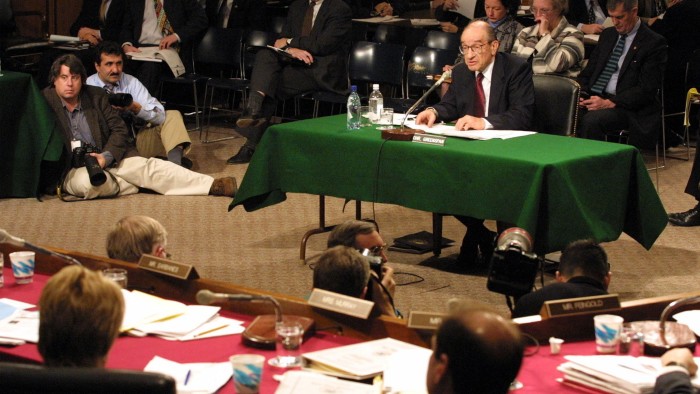Unlock the White House Watch newsletter for free
Your guide to what the 2024 US election means for Washington and the world
The writer is an FT contributing editor
In January of 2001, not yet a full week into the presidency of George W Bush, Alan Greenspan appeared before the Budget Committee of the US Senate. This was not part of the semi-annual event where the chair of the board of governors of the Federal Reserve reports to Congress on monetary policy. Rather, he was an expert, there to help with a problem. In 2001, the US was in danger of paying down its debt completely and accumulating a surplus.
Greenspan was not in favour of a surplus. It would have to be invested in private financial assets, he pointed out, distorting capital markets and making it “exceptionally difficult to insulate the government’s investment decisions from political pressures”. Greenspan was explicitly against a sovereign wealth fund, but he needn’t have worried. Over the next two-and-a-half decades the federal government paid for tax cuts, a war, more tax cuts, another war, a stimulus, more tax cuts, another stimulus, and is now once again contemplating tax cuts.
When Greenspan spoke, federal debt was 55 per cent of GDP and headed down. It’s now at 120 per cent, headed up. But all other things are not equal, and this month, the US president directed his Treasury and commerce departments to develop a plan for a sovereign wealth fund. There is no wealth but there is a sovereign, and by God he will have his fund.
If we define them broadly, there already are sovereign wealth funds in the US. Public pension and retirement funds buy private assets to guarantee a return. The fund for federal employees, for example, held $845bn in assets as of its most recent report. The fund for California’s public employees, the next largest, holds $597bn. America’s states, too, hold rainy-day funds. Wyoming could survive for more than eight months on its fund alone.
These funds are all hemmed in with boards and oversight and demands for regular, predictable payouts. They lack the one thing that makes a sovereign wealth fund so much fun: discretion.
Here the White House can look abroad for a model. Since 1996, Norway’s central bank has run a fund that converts oil revenue into financial assets, providing a 6.3 per cent annual return and a significant contribution to the country’s annual budget. The fund buys mostly foreign equities and debt but has some discretion to invest in real estate and renewable energy projects. Saudi Arabia’s Public Investment Fund makes splashy buys abroad.
The original goal of both of those funds, however, was to manage exactly what Greenspan was worried about in 2001. Both countries, looking at growing pools of oil wealth, wanted to keep their surpluses offshore, where they couldn’t distort the domestic economy. But as Greenspan pointed out, any investment fund to dispense with state wealth runs the risk of becoming a way for the sovereign to dispense favours. Norway’s fund has goals beyond profit, but restrains them with impeccable transparency. Saudi Arabia’s fund has social goals, too, with fewer restraints and less sunlight.
There is no onshore American surplus, however, to move offshore before it does any damage. The White House’s fact sheet for the executive order declares that the US already holds $5.7tn in assets, a true number that is useful only if we are wilfully blind to the actual balance sheet of the actual US. Of that $5.7tn, only $1.2tn is in cash or gold. The rest is illiquid — inventory, property, plant, and $1.7tn in loans receivable (money owed to the government).
It’s far more likely that the US is going to do what it’s always done. It will sell treasuries into financial markets to raise cash to spend on its priorities. What the White House is actually proposing, then, is a development fund, something like Ireland’s Strategic Investment Fund. On the liability side of America’s investment bank, there would be treasury obligations. On the asset side, whatever assets the White House fancies. That’s not a sovereign wealth fund, and it’s not even really a development fund. It’s just what America already does.
There’s a different way to look back at what’s happened since Greenspan’s testimony. The US hit a gusher: not oil, but treasuries. It sold them at will, at volumes and borrowing costs that did not obey any predictive laws of finance. The proceeds went straight back into the domestic economy, directed by Congress as a governing board. Congress invested in tax cuts that stimulated financial markets, in contracts that stimulated defence firms, and in stimulus cheques after a financial crisis and a pandemic.
America already is a sovereign wealth fund. What came out of it is what America is today.
https://www.ft.com/content/568b2ac8-fce0-4b10-b5a1-ace52f1e1421


